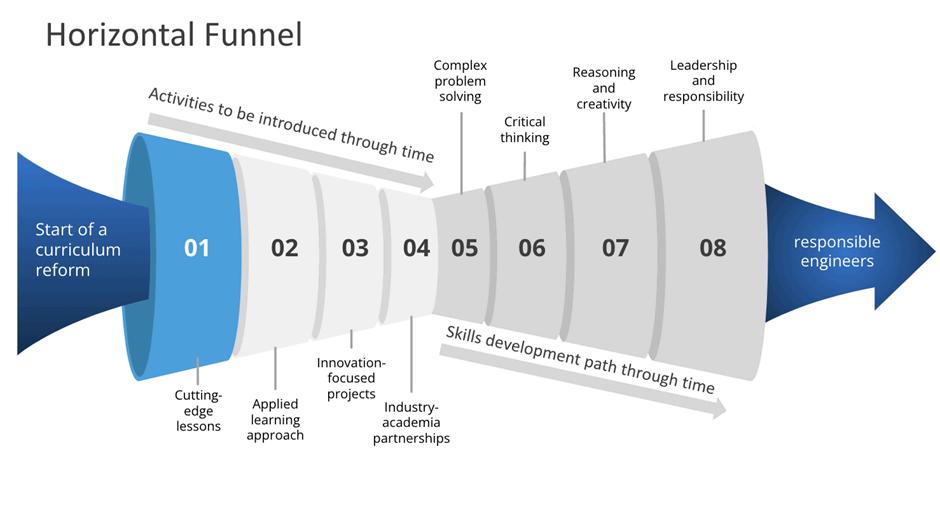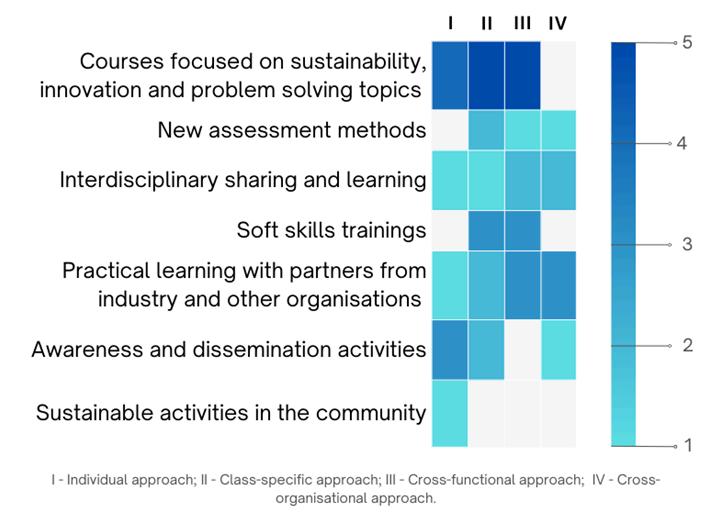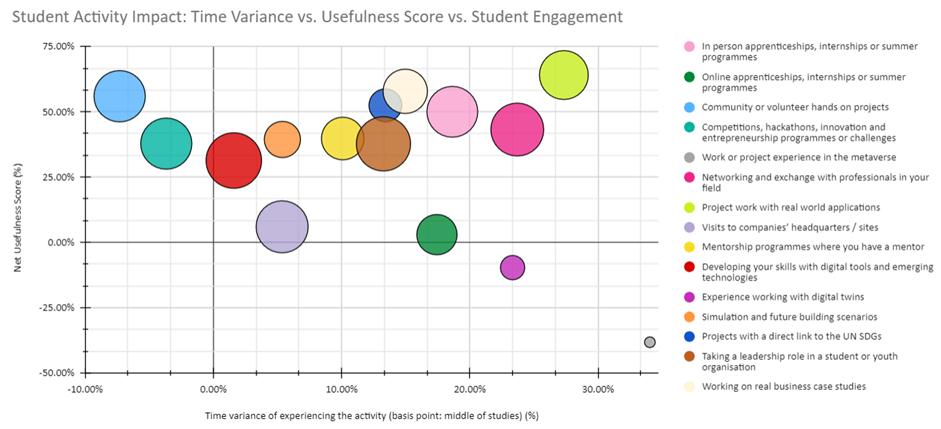Students’
Perspective on Innovation,
Entrepreneurship and New Technologies for a Responsible STEM Education
Ljiljana Kherawi1
Board of European Students of Technology Brussels, Belgium
Alessio Fino
Board of European Students of Technology Brussels, Belgium
Irina Milojković
Board of European Students of Technology Brussels, Belgium
Conference Key Areas: Curriculum development and emerging curriculum models in engineering, Engineering skills, professional skills, and transversal skills
Keywords: Curriculum, Innovation, Entrepreneurship, New technologies, Skills
ABSTRACT
In order to achieve net-zero carbon emissions in the world by 2050, it is necessary to shape responsible and skilled individuals through Higher STEM Education. This paper focuses on assessing the perspective of STEM students regarding the incorporation of new curriculum activities and topics aligned with the evolving needs of today’s society Specifically, the study evaluates the inclusion of innovation, new technologies, and entrepreneurship in the curriculum, through a series of sessions, workshops, and discussions conducted in summer 2023. The paper highlights the significance of an innovative curriculum in STEM education and identifies the way
1 Corresponding Author
Ljiljana Kherawi ljiljana.kheirawi@best-eu.org
essential skills and competencies of future engineers can be developed to face today's constantly changing world. This paper proposes applicable actions for institutions and associations involved in European Higher Education. By emphasising the importance of an adaptive curriculum, this research contributes to the ongoing dialogue on shaping STEM education to align with the demands of the future, therefore fostering the development of individuals equipped to address the challenges posed by the rapidly evolving global landscape.
1 INTRODUCTION
1.1
General overview
This paper represents the perspectives of STEM students regarding the inclusion of a new and innovative study curriculum in STEM education. It is essential that engineers understand the challenges of the future of this planet and society, and realise the impact their solutions have (Bronstein and Lampe 2023). The challenges that engineers are expected to tackle in the future (Zhang and Morris 2020), can only be solved if the skills and knowledge related to them are integrated into Higher Education Institutions (HEI) policies and strategies (Hobusch and Froehlich 2021). Several technological sectors are increasingly in need of graduates who are aware, creative, able to keep up with constant innovation, and who do not hesitate to delve into challenges. In order to bridge the gap between science and engineering education and the skills needed for industries and communities of the 21st century, there has been a growing need from industry bodies to educate STEM students not just in innovation and new technologies, but also in entrepreneurship (Amalua and Shorta 2023, Lynch and Kamovich 2021, Hermann and Bossle 2020). Interestingly enough, the current integration of entrepreneurship, innovation, and new technologies in formal engineering education appears to be far from accomplished, although various studies agree on the importance of doing so (Bronstein and Lampe 2023, Marjoram 2015, Kaminsky 2017, Höller and Vorbach 2017). Hence, through an exploratory project, this paper aims to address the following research question: How should STEM studies be shaped according to the STEM students in order to provide them with the necessary tools to act responsibly?
1.2 Objectives of the research
Objective 1: Identify which skills are perceived as more crucial in the educational path of STEM students, by delving into the students' and young graduates’ experiences within their educational path.
Objective 2: Define which parts of the mentioned topics should be most integrated into the curriculum.
Objective 3: Determine the activities through which the following topics can be integrated into the curriculum and ways in which they can influence students to achieve the necessary skills for the future.
2
METHODOLOGY
Data from November 2022 to August 2023 were analysed in two phases: primary research at the BEST Symposium on Education (BSE) and a secondary literature review. The BSE gathered opinions on STEM education from students at 16 universities across 10 European countries, with a focus on entrepreneurship, innovation, and technologies for sustainable development. This was complemented by a survey of 226 students from 63 universities, which examined the inclusion of sustainability in current studies, critical skills for the future to address global challenges, and activities to develop those skills. The survey data helped understand the usefulness of certain activities, the timing of student experiences with them during their studies, and the overall student engagement, ascertained through multiple-choice questions in a matrix format. Secondary research involved reviewing existing literature on the inclusion of innovation, new technologies, and entrepreneurship in STEM education curricula, as well as analysing data obtained from the primary research. Analysis methods included statistical quantification, pattern identification, idea generation, theoretical testing, and comparative evaluation. The Net Usefulness Score (NUS) and time variance were calculated to assess the impact of activities and the timing of student engagement.
For assessing time variance, a normalised formula was applied by assigning numerical values to for each phase point of the studies (0 for Early studies, 1 for Middle of studies and 2 for End of studies). The number of students for each period was multiplied with the given value, and the resulting products were summed. The final sum was then divided by the total number of students who participated in the activity, with the result expressed as a percentage.
3 RESULTS
3.1. Skills development towards responsible engineering
3.1.1. Results
This section outlines proposed curriculum changes to foster responsible engineering. Key recommendations include integrating state-of-the-art technology lessons and practical work, with over 50% of respondents favouring hands-on experience over theoretical learning. Industry-academia partnerships and entrepreneurship skills are also highlighted as vital for adapting to rapid technological advancements. Figure 1 illustrates the proposed activities and their sequential introduction, alongside their role in enhancing soft skills like problem-solving, creativity, and leadership, ultimately shaping responsible engineers. Entrepreneurship skills are considered irreplaceable in the curriculum of engineering students to allow engineers to adapt to increasingly fast-changing scenarios and technologies (European Commission, 2018).

Figure 1 Horizontal funnel showing activities to be introduced in the curriculum (on the left, the order of activities is narrowing down towards right proportionally to introduction timing) and their impact on soft skills for responsible engineers (on the right, the order of activities is expanding towards right proportionally to development timing)
Through these activities, students recognise that first they would have the opportunity to develop complex problem solving skills. All students agreed that experiential learning will help them perceive the larger picture of the current sustainability challenges that the world is facing today, which in turn will have a positive influence on their creativity and promote critical ways of reasoning. Leadership and responsibility would be developed over time, resulting in responsible engineers post graduation.
3.1.2. Recommendations
To prepare engineers for the future, educational institutions must update curricula to reflect industry needs and societal expectations. This involves enriching programs with case studies, entrepreneurship courses, internships, and projects focused on innovation. Strengthening ties with industry is crucial for exposing students to real-world challenges and integrating innovation, entrepreneurship, and emerging teaching methods through collaboration. Incorporating state-of-the-art technologies and addressing global challenges within the curriculum are essential steps in shaping responsible engineers equipped for the 21st century
3.2 Learning activities for enhancing skills of responsible engineer
3.2.1.
Results
Five student focus groups evaluated activities for fostering sustainable development and responsible engineering education. Figure 2 illustrates these activities and their preferred implementation scales: individual, class-specific, cross-functional, and
cross-organisational. The consensus was that sustainability, innovation, and problem-solving courses are most beneficial, suitable for various implementation levels. Activities like podcasts and industry partnerships were favoured for enhancing practical skills and soft skills development. The significance of leadership, communication, and creativity in achieving an entrepreneurial mindset is supported by Škare and Tejero (2022). Workshops, lectures, and internships with diverse stakeholders were also recommended for practical learning experiences.

Figure 2 Heat map showing correlation between specific activities to be introduced in the curriculum and frequency how often they were mentioned among the focus groups, categories by the scale of the implementation (from I - Individual approach to IVcross-organisational approach)
3.2.2. Recommendations
To advance engineering education, students recommend a curriculum that emphasises practical application through hands-on projects and entrepreneurial activities. Collaboration across different majors should be encouraged to foster a diverse skill set, while soft skills development must be integrated via workshops and conferences. Additionally, innovative assessment methods need to be adopted to accurately track students' progress and ensure they are equipped for the challenges of responsible engineering.
3.3 Learning activities aimed at enhancing creativity and innovation
3.3.1. Results
Survey results, as illustrated in Figure 3, analyse student perspectives on the relevance and timing of activities that promote creativity and innovation within the curriculum. The Net Usefulness Score (NUS) ranges from -100% to +100%, reflecting when activities are experienced during studies: early (-100%), middle (0%),
or late (+100%). The bubble size indicates the number of students who participated in each activity Most activities are encountered mid-studies, with "Community or volunteer hands-on projects" and "Competitions, hackathons, innovation and entrepreneurship programs/challenges" often introduced earlier. Projects with real-life applications received the highest NUS of 67%, experienced by over 50% of students, mainly towards the end of their education (time variance of 27%). Community projects, engaged in early by more than 60% of students, also scored a high NUS of 56%. In contrast, "Simulation and future building scenarios" and "Projects linked to the UN SDGs" are highly valued (NUS of 39% and 52%, respectively) but less accessible, with fewer than half of the students having the opportunity to engage with them, typically in the latter half of their studies. Notably, activities with negative NUS, specifically "Experience working with digital twins" and "Project experience in the metaverse," had the least engagement and were introduced late in the curriculum, indicating a need for earlier exposure to these emerging technologies.

3 Bubble chart representing Student Activity Impact: Time variance vs Net usefulness score vs. Student Engagement of specific activities
3.3.2.
Recommendations
It is evident that the most useful and impactful opportunities for students are available to them only later in the studies. We suggest following the industry trends and making sure that the curriculum is up to date with all of the innovation and new skills that will be desirable for new engineers to have. Implementing “Simulation and future building scenarios” and “Projects with direct link to the UN SDGs” early in the engineering studies, would be the most impactful educational activity to be introduced in the curriculum of STEM students because they have a really high usefulness score compared to the number of students who had a chance to experience them (the smallest bubble). The second most impactful improvement would be reached by developing a system that allows any student to participate in
those kinds of activities since not many students had a chance to experience them during their studies. Another important course of action is to implement additional courses on Project work with real world applications. In person apprenticeships, internships or summer programmes and Networking and exchange with professionals in your field both have a very high usefulness score, but face the barrier of having late time experience, thus earning a place in education only in very specific use cases and not as activities carried out across the board. We appeal to the inclusion of the mentioned activities earlier during stem studies.
4 EVOLUTION OF STUDENTS OPINIONS OVER THE YEARS
The paper submitted by BEST for the SEFI 2018 conference, titled "A Student's Perspective on Entrepreneurship and Innovation in European STEM Education," underscored the importance of entrepreneurial skills in engineering education. The paper analysed data from previous BEST Symposia on Education over the 13 years preceding the conference submission and related to four Events on Education (EoEs) (Porto 2017, Ankara 2015, Ljubljana 2010, and Zagreb 2009) organised by BEST, whose topics are directly or indirectly related to innovation and entrepreneurship. It advocated for competencies that enable students to be proactive and confident. The paper recommended practical, hands-on entrepreneurship education, facilitated through EoEs, to capture student opinions. It also highlighted students' desire for more practical projects and stronger university support for entrepreneurship, alongside a call for enhanced academia-industry collaboration to ensure curricula reflect real-world challenges. In our current research paper, students advocate for a curriculum that embraces new technologies to keep pace with rapid technological advancements. The paper emphasises the importance of practical and experiential learning, urging educators to provide students with real-world examples and opportunities to tackle sustainability challenges directly. It stresses the need for skills like problem-solving, critical thinking, and active learning, while maintaining that entrepreneurship is essential for navigating fast-evolving scenarios. Additionally, it calls for the early introduction of topics such as sustainability, innovation, and problem-solving in educational programs to better prepare students for their future responsibilities. The evolution of student opinions from 2005 to the present shows a significant shift from a focus on entrepreneurship to a broader inclusion of innovation and new technologies, reflecting an expanded vision for STEM education. The latest paper emphasises the critical role of technology, advocating for its integration early in the curriculum to meet the changing demands of the job market and societal needs. While both papers underscore the importance of practical application, the current paper places substantial emphasis on sustainability, aligning with the global movement towards responsible engineering practices. In summary, over the years, students have maintained the importance of entrepreneurship but have expanded their focus to include innovation and new technologies. There is a clear trend towards integrating these topics earlier in the curriculum and aligning them with
real-world challenges, particularly those related to sustainability The evolution reflects a maturing perspective that recognises the multifaceted role of engineers in society
5 SUMMARY AND ACKNOWLEDGEMENTS
To ensure constant adaptation and innovation in the curriculum of HEI in Europe, it is necessary to follow and understand the needs of today's students. This research pinpoints direction of those changes, placing the largest emphasis on the following:
1. Universities should focus more on practical and project work for students, throughout their whole studies;
2. Universities should strengthen the relationships with industry and other partners, in order to provide opportunities to students to learn on real-world problems;
3. Universities should expand existing curriculum with new teaching activities, such as soft skills training and workshops organised together with industry and other institutions. The topic of sustainability and entrepreneurship should also be included in formal course modules.
4. These activities have a high usefulness score but a small number of students had a chance to experience them during their studies. Therefore, HEI and other stakeholders (including industry) should focus on introducing them earlier in engineering curricula:
● Simulation and future building scenarios;
● Projects with direct links to UN SDGs;
● Working on real business case studies.
5. Meanwhile we recommend to also keep the activities that already have a high usefulness score and a high participation such as:
● Community and volunteer hands on projects
● Project work with real world applications
● In person apprenticeships, internships or summer programmes
To achieve future sustainability goals, we must educate engineers today Effective education requires curriculum reforms, with investment from all stakeholders, to equip engineers with the necessary knowledge and skills to address forthcoming challenges. This paper invited professors and Universities to be the catalyst of this change.
REFERENCES
[1] Bronstein A.A., S.Lampe, “Fostering future engineers as transformational agents: Integrating sustainability and entrepreneurship in engineering education”, Procedia Computer Science, 958, (2023), https://doi.org/10.1016/j.procs.2023.01.372
[2] Zhang G., E. Morris, “Research Opportunities and Challenges in Engineering System Evolution”, Journal of Mechanical Design, Volume 142, Issue 8, (2020), https://doi.org/10.1115/1.4045908
[3] Hobusch U., D.E. Froehlich, “Education for Sustainable Development: Impact and Blind Spots within Different Routes in Austrian Teacher Education”, (2021), https://doi.org/10.3390/su132111585
[4] Amalua E.H., M. Shorta, “Critical skills needs and challenges for STEM/STEAM graduates increased employability and entrepreneurship in the solar energy sector”, Renewable and sustainable energy reviews, Volume 187, (2023): page 7, Fig. 10. and page 8 paragraph 1 and Fig. 11. https://doi.org/10.1016/j.rser.2023.113776
[5] Lynch M. and U. Kamovich, “Combining technology and entrepreneurial education through design thinking: Students reflection on the learning process”, Technological Forecasting and Social Change, Volume 164, (2021), https://doi.org/10.1016/j.techfore.2019.06.015
[6] Hermann R. R. and Bossle M. B., “Bringing an entrepreneurial focus to sustainability education: A teaching framework based on content analysis”, Journal of cleaner production, Volume 246, (2020), https://doi.org/10.1016/j.jclepro.2019.119038
[7] Marjoram T., Transforming Engineering Education: For Technological Innovation and Social Development (2015). In: Christensen, S., Didier, C., Jamison, A., Meganck, M., Mitcham, C., Newberry, B. (eds) International Perspectives on Engineering Education, pp 321–341.Philosophy of Engineering and Technology, vol 20. Springer, Cham. https://doi.org/10.1007/978-3-319-16169-3_16
[8] Kaminsky P., The future of engineering education, (2017), https://engineering.berkeley.edu/news/2017/11/the-future-of-engineering-education/
[9] Höller H., Vorbach S., “Entrepreneurship in engineering education”, (2017), Paper presented at the International Conference on Interactive Collaborative Learning, Belfast, United Kingdom, 21-23.09.2016. https://doi.org/10.1007/978-3-319-50340-0_43
[10] European Commission. Entrepreneurship and SMEs-Female Entrepreneurs. Directorate-General for Internal Market, Industry, Entrepreneurship and SMEs.
Accessed: Jul. 18, 2018.
https://single-market-economy.ec.europa.eu/smes/supporting-entrepreneurship/wom en-entrepreneurs_en?prefLang=pt
[11] M. Škare, C. Blanko-Gonzalez-Tejero, “Scientometric analysis on entrepreneurial skills: creativity, communication, leadership: How strong is the
association?”, Technological Forecasting and Social Change, Volume 182, (2022), https://doi.org/10.1016/j.techfore.2022.121851
[12] C. Bombaca, F Draxler, “A students’ perspective on entrepreneurship and innovation in European STEM Education”, (2018), paper presented at SEFI Annual conference, Copenhagen, Denmark, 17-21.09.2018.
